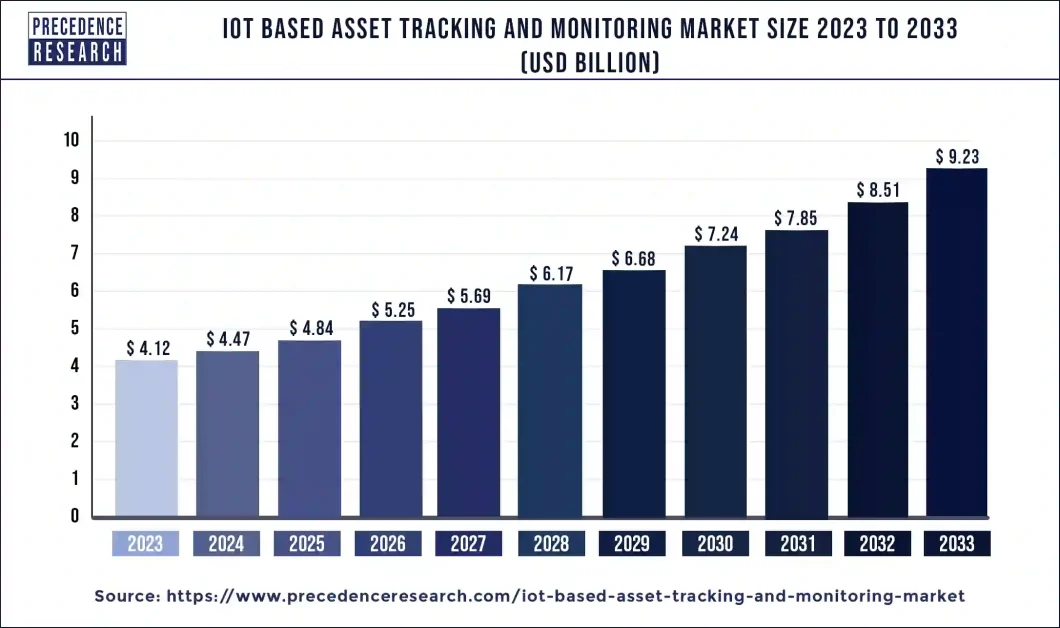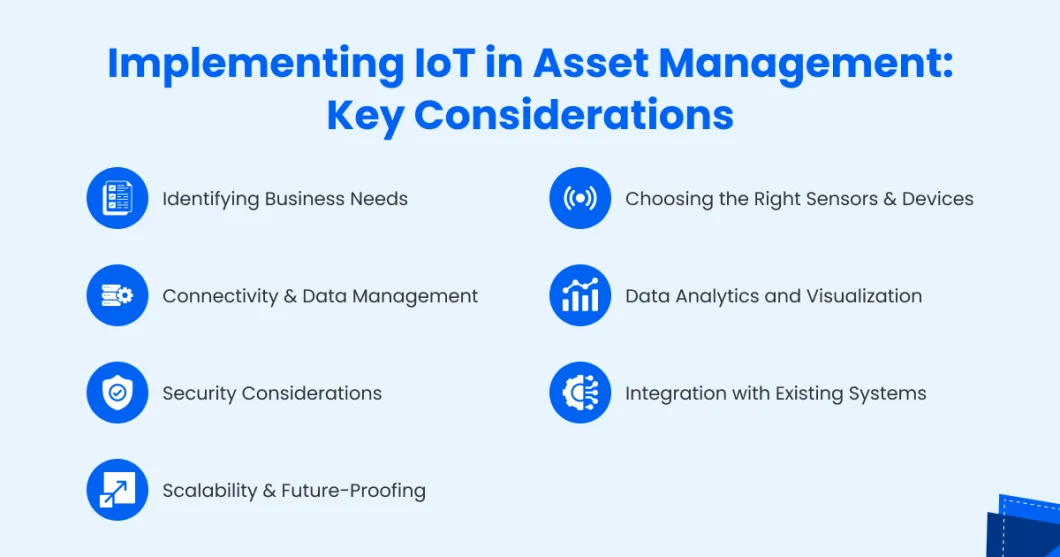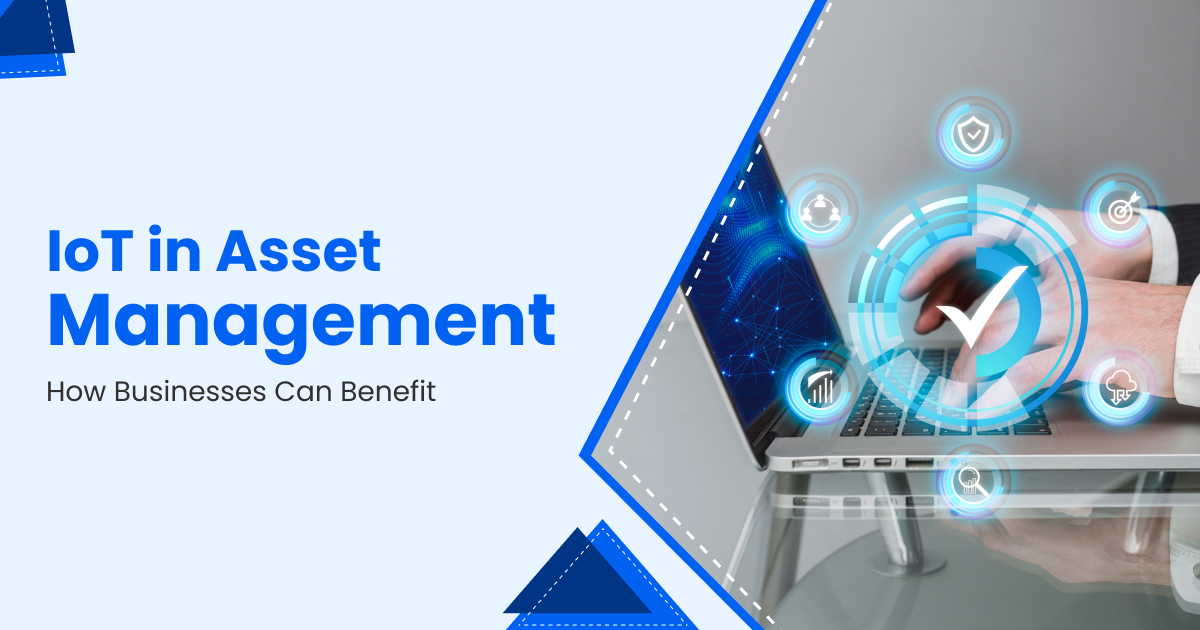In today’s data-driven world, businesses of all sizes recognize asset management’s immense value. However, traditional methods often rely on manual processes and lack real-time insights, hindering optimal asset utilization and leading to potential problems.
The emergence of the Internet of Things (IoT) transforms asset management, offering a powerful solution for businesses seeking greater efficiency, cost savings, and improved decision-making.
Table of Contents
- IoT-Based Asset Tracking and Monitoring Market Size and Growth
- What is IoT in Asset Management?
- Key Benefits of IoT in Asset Management
- Examples of IoT Applications in Asset Management
- Implementing IoT in Asset Management: Key Considerations
- The Role of IoT Development Companies and Consulting Services
- Conclusion: The Future of Asset Management is Connected
IoT-Based Asset Tracking and Monitoring Market Size and Growth
The global IoT-based asset tracking and monitoring market size was USD 4.12 billion in 2023, accounted for USD 4.47 billion in 2024, and is expected to reach around USD 9.23 billion by 2033, expanding at a CAGR of 8.4% from 2024 to 2033.

What is IoT in Asset Management?
The Internet of Things (IoT) refers to the network of physical devices embedded with sensors, software, and other technologies that collect and exchange data. In asset management, IoT sensors are attached to physical assets, allowing them to communicate data about their condition, location, and performance. This data is then transmitted wirelessly to a central platform for analysis and visualization.
Here’s how it works:
- Sensors on equipment collect data on temperature, vibration, pressure, and other relevant metrics.
- This data is transmitted wirelessly to a cloud-based platform for centralized storage and analysis.
- Advanced analytics tools provide insights into asset health, usage patterns, and potential maintenance needs.
By leveraging IoT in asset management, businesses gain a wealth of benefits that can significantly improve their operations.
Key Benefits of IoT in Asset Management
1. Predictive Maintenance:
- Traditional maintenance schedules are often reactive, addressing problems only after they occur. IoT enables predictive maintenance by analyzing sensor data to identify potential equipment failures before they happen.
- This allows for proactive maintenance interventions, preventing costly downtime, extending asset lifespan, and optimizing resource allocation.
For example: An IoT sensor on a critical manufacturing machine can detect slight changes in vibration, indicating a potential bearing issue. Predictive maintenance allows you to replace bearings before they fail, preventing costly production line stoppages.
2. Improved Asset Utilization:
- Real-time data on asset location and usage allows for better tracking and optimization of resource utilization. Businesses can identify underutilized assets and redistribute them to areas of higher demand.
- This helps to ensure that assets are deployed effectively, maximizing their value and reducing the need for additional equipment purchases.
For example: A construction company can use IoT to track the location and usage of its fleet vehicles. Use this data to optimize delivery routes, enhance dispatch efficiency, and ensure that vehicles operate exactly where and when needed.

3. Enhanced Operational Efficiency:
- By automating data collection and analysis, IoT eliminates the need for manual processes associated with traditional asset management. This reduces human error and improves the overall accuracy and efficiency of operations.
- Additionally, real-time data on asset performance allows for faster identification and resolution of operational issues, minimizing disruptions and improving overall productivity.
For example: A food processing plant can use IoT sensors to monitor temperature and humidity levels in storage units. Real-time alerts can be triggered if these parameters fall outside the optimal range, allowing for swift corrective action to avoid product spoilage.
4. Increased Safety and Security:
- Use IoT sensors to monitor environmental conditions in facilities, such as temperature, humidity, and air quality. This data helps identify potential safety hazards and allows you to take preventive measures.
- Additionally, asset tracking features can be used to deter theft and improve security by monitoring the location and movement of valuable equipment.
For example: An oil and gas company can use IoT sensors to monitor pipelines for leaks and corrosion. Early detection of these issues can prevent potentially catastrophic accidents and environmental damage.
According to a recent study by McKinsey & Company, IoT in asset management has the potential to generate up to $4 trillion in annual business value by 2025.
Examples of IoT Applications in Asset Management
Here are some specific examples of how businesses across various industries are leveraging IoT in asset management:
- Manufacturing: Track production line equipment performance, predict maintenance needs, and optimize resource allocation.
- Transportation & Logistics: Monitor the location and condition of vehicles in real-time, improve route optimization, and ensure timely deliveries.
- Utilities: Track energy consumption in buildings and facilities, identify areas for energy conservation and optimize maintenance schedules for power grids.
- Healthcare: Monitor medical equipment performance, track the location of critical medical supplies, and improve patient care efficiency.
- Construction: Track the location and utilization of construction equipment, optimize project scheduling, and improve safety on job sites.
The possibilities for applying IoT in asset management are vast and continue to evolve as technology advances.
Implementing IoT in Asset Management: Key Considerations
Businesses considering implementing IoT in asset management should carefully evaluate several factors:

- Identifying Business Needs: Clearly define the specific challenges and objectives you aim to address through IoT implementation.
- Choosing the Right Sensors and Devices: Select sensors compatible with your assets and collect data relevant to your business needs. Consider factors like cost, durability, and battery life.
- Connectivity and Data Management: Ensure a reliable and secure method for data transmission from sensors to the cloud platform. Consider factors like network bandwidth, security protocols, and data storage needs.
- Data Analytics and Visualization: Invest in robust data analytics tools to translate raw sensor data into actionable insights. User-friendly visualization tools are crucial for clear communication and informed decision-making.
- Security Considerations: Implement robust security measures to protect sensitive data collected from IoT devices. This includes encryption protocols, access controls, and regular security audits.
- Integration with Existing Systems: Ensure compatibility and seamless data integration between your IoT platform and existing enterprise resource planning (ERP) or other relevant software systems.
- Scalability and Future-Proofing: Choose an IoT solution that can scale to meet your growing business needs and accommodate future technological advancements.
The Role of IoT Development Companies and Consulting Services
Implementing a successful IoT solution for asset management often requires specialized expertise. Here’s where partnering with an IoT development company or utilizing IoT consulting services can be highly beneficial:
- IoT Development Companies: Provide expertise in designing, developing, and deploying custom IoT solutions tailored to your specific asset management needs.
Benefits: Access to a team of experienced engineers, developers, and data scientists skilled in creating and integrating IoT solutions. - IoT Consulting Services: Offer guidance and support throughout the IoT implementation process, from initial planning to system integration and ongoing optimization.
Benefits: Gain valuable insights and recommendations from experienced professionals to ensure a successful IoT deployment.
An example: A manufacturing company considering IoT for predictive maintenance can benefit from an IoT development company. The development company can design and deploy a sensor-based system that monitors equipment health and provides real-time data for predictive maintenance strategies.
By working with experienced partners, businesses can navigate the complexities of IoT implementation and unlock the full potential of this technology for their asset management needs.
Conclusion: The Future of Asset Management is Connected
The integration of IoT in asset management is rapidly transforming how businesses manage their physical assets. Businesses can significantly improve efficiency, cost savings, and overall asset performance by leveraging real-time data and advanced analytics. As sensor technology continues to evolve and connectivity infrastructure expands, the possibilities for applying IoT in asset management are limitless.
Considering implementing IoT in your asset management strategy? HashStudioz is a leading provider of IoT development solutions, offering expertise in sensor integration, data analytics, and custom application development. Our team of experts can help you assess your needs, design a comprehensive IoT solution, and ensure a successful implementation that drives measurable business value.


